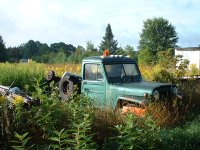 It is always interesting exploring an abandoned farm. From the forgotten rusting tools and the structural decay to the wild growth of untamed plant life. In reviewing the images we take and observation of effects left by the former occupants, it is difficult not to imagine a simpler, richer way of life lost.
It is always interesting exploring an abandoned farm. From the forgotten rusting tools and the structural decay to the wild growth of untamed plant life. In reviewing the images we take and observation of effects left by the former occupants, it is difficult not to imagine a simpler, richer way of life lost.
It is generally believed that the transition in Ontario between pioneer or traditional farming and the modern 20th century farming occurred between 1900 to 1950. After this point in time, farming became highly mechanized and agriculture products more specialized. This point in time also marks a dramatic movement of rural populations to the cities. The number of farms in Ontario had dropped from almost 13% in a ten-year period from 1991 to 2001. What must also be considered is that the size of the average farm had also increased, hinting at a move from family-orientated operations to a big-business approach.

Ontario's agri-food sector is the largest and the most diversified in Canada, marketing more than 200 agricultural commodities with an estimated on-farm production value of nearly $8.47 billion in 2002. Food and beverage processing industry is the second largest manufacturing sector in Ontario and contributed $9.5 Billion towards the GDP in 2001; during the first nine months of 2002, their contribution to GDP rose by 5%.
There are approximately 97,000 operators of the 67,500 census farms in the province, 95,000 employees in the food, beverage and tobacco processing sector, 275,000 jobs in the foodservice industry and 160,000 jobs in food retailing. Given these strong numbers, it is somewhat alarming that the sector receives only 0.7% of the entire provincial budget. This chronic underfunding has led to many problems in other areas of agriculture.



No comments:
Post a Comment